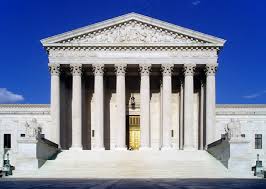By Paul Rozycki
Just when you thought you’ve heard enough about gerrymandering, and the ballot proposals to end it—there is one more line of attack. Now the courts are getting involved.
Two previous columns in past issues of East Village Magazine (Part One here, Part Two here) have outlined the problems and history of gerrymandering, drawing oddly shaped election districts to favor one party over another. A second column also reviewed a proposal scheduled for the November ballot, which would create a non-partisan commission to draw fairer election districts for Michigan.
The courts get involved
As voters prepare to decide the issue, there is one more important group entering the fray to undo and limit the gerrymander—the courts. A number of states have brought cases to the U.S. Supreme Court with the intent of finding the current gerrymandering process unconstitutional.
While the ballot proposal to amend the Michigan Constitution is complicated, many of the issues raised in court may be even more intricate. The ballot proposal to end gerrymandering is fairly straightforward—-create a non-partisan commission (complex as it is) and let them do their work. The courts deal with different issues. While gerrymandering may be unfair and perhaps even harmful to democracy, is it unconstitutional? On what basis? And even if it is, what can the nine members of the Supreme Court do to end the practice in 50 states and 435 congressional districts?
Is it a “political question?”
 Perhaps the most surprising thing is that the U.S. Supreme Court has taken the case at all. The Supreme Court normally has a choice of which cases they choose to accept—and the typically reject at least 95 percent of those cases appealed to it. One of the more common reasons for declining to hear a case is that it presents a “political question,” an issue that should be decided by the elected officials, rather than a non-elected panel of judges. For that reason, for many years, gerrymandering was considered beyond the court’s jurisdiction and they avoided taking such cases.
Perhaps the most surprising thing is that the U.S. Supreme Court has taken the case at all. The Supreme Court normally has a choice of which cases they choose to accept—and the typically reject at least 95 percent of those cases appealed to it. One of the more common reasons for declining to hear a case is that it presents a “political question,” an issue that should be decided by the elected officials, rather than a non-elected panel of judges. For that reason, for many years, gerrymandering was considered beyond the court’s jurisdiction and they avoided taking such cases.
But now the issue is emerging in lower courts, with conflicting results. Within the last month one federal court panel ordered North Carolina to redraw its election map, while another court upheld a Pennsylvania plan, saying they had no business getting involved in political matters. That conflict among lower courts may force the Supreme Court to take action. The court has already heard arguments over gerrymandering in Wisconsin, and is expected to hear a similar case from Maryland. Other cases from Michigan and North Carolina are working their way through the system, and more are likely. The Michigan case has been filed by former Democratic Party Chair Mark Brewer with the support of the League of Women Voters.
What is fair?
It’s easy to look at some of the maps generated in gerrymandered states and come to the conclusion that the whole process is unfair. But judges like precise legal definitions. Some judges have said that only “excessive” gerrymandering is unfair and a constitutional violation. What is “excessive”? What is fair? What is unfair? If a state is 50 percent Democratic and 50 percent Republican, but elects 55 percent of one party, is that unfair? What if it’s 60 percent? What about a 70 percent advantage for one party? Where should the courts draw the line? In the Wisconsin case, the Republicans won almost two-thirds of the legislative seats with less than half the popular vote. Nationwide, the Republicans have been the major beneficiaries of gerrymandering. But they are hardly alone. Given the opportunity, Democrats have been willing and able to gerrymander just as ardently as Republicans. In Wisconsin the Republicans have given themselves an advantage with their election districts. However, in an unusual move, the Supreme Court has also agreed to hear arguments against gerrymandering from Maryland, where Democrats have the advantage. Reviewing cases from states where both Republicans and Democrats have gerrymandered is likely an attempt by the court to avoid favoring one party over the other. Some argue that only the courts could really end gerrymandering, since politicians of either party will use it to their advantage.
A way to measure gerrymandering?
It’s easy to say that gerrymandering is unfair, but how do you measure it? In the Wisconsin case litigants have tried to provide an objective measure of unfairness with a concept called the “efficiency gap.” It’s a complex statistical model, but basically it’s a measure of wasted votes. If one party is packed heavily into one district, all those votes it gets beyond 50 percent are, in effect, wasted—it doesn’t need them to win. Similarly, if a party has no realistic chance of winning a district all those votes for the certain loser are also wasted. The combination of the wasted votes on the winning side and the losing side produces a measure of the “efficiency gap.” That’s the “packing” and “cracking” most commonly used to create gerrymandered districts.
Skeptics of this measure contend that if the “efficiency gap” were used it would invalidate almost a third of all state election maps in the country. Further, some argue that the courts shouldn’t get involved in what they call a “social science stew or sociological gobbledygook” of applying and interpreting a complex and untried statistical measure. Other statistical tests have been proposed and face the same criticism.
But trying to determine what is or isn’t fair is only part of the problem. Let’s say the court finds that both Wisconsin and Maryland have drawn unfair election districts. What then? Almost certainly the court doesn’t want to get directly involved in drawing 435 congressional districts, not to mention thousands of state legislative districts, county districts, and city council districts in all 50 states.
What solutions?
While a decision to limit gerrymandering could get the federal courts involved in the minutiae of state and local government, it’s done it before when it dealt with desegregation of public schools. In the past the courts have overturned some election maps where they discriminated along racial lines. It’s possible that the Supreme Court could do a number of things to end or reduce the impact of gerrymandering. It could allow states to submit plans to lower federal courts, once some guidelines for “fairness” were set. It could also require non-partisan commissions to be used, instead of having politicians drawing election district lines. Some have even suggested that computer programs might be used to limit human political influence in the mapmaking process. Most likely, whatever solution the court orders, if any, would not affect the 2018 election, but would begin with the 2020 election, where those elected in that year would draw political maps for the next decade.
Whatever the Supreme Court decides, we should have a ruling by June.

Paul Rozycki
EVM political columnist Paul Rozycki can be reached at paul.rozycki@mcc.edu.


You must be logged in to post a comment.